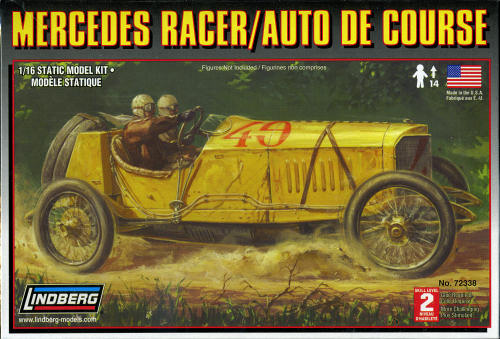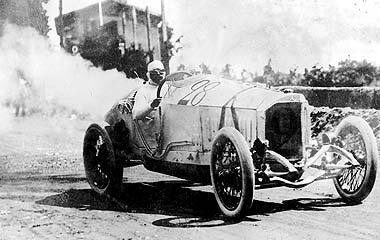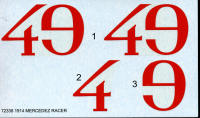
| KIT #: | 72338 |
| PRICE: | $ 14.35 at www.greatmodels.com |
| DECALS: | One option |
| REVIEWER: | Scott Van Aken |
| NOTES: | Re-release of an oldie |

| HISTORY |
 Mercedes
successful race car was built for 1914 Grand Prix of France. Observe that this
is still a Daimler. Jellineck. The competition model took the 1, 2 and third
places. The driver of the wining car was Lautenschlager. Still 1922 the model
was a winning car, modified of course. Among all races, it had success at Targa
Florio with Masetti as driver. Not at this time it was always 1 driver and 1
mechanic who sat in the car. The engine was based on Maybach aircraft engines
and could reach 3200 rpm and had a power output of 115 ps. Cylinder volume was
4483 cc. It gave a top speed of 180 km/h. Benz patent on steering was free now
and the V-formed cooler became a signum for Mercedes. The 3 pointed star was
registered already 1909 by Daimler.
Mercedes
successful race car was built for 1914 Grand Prix of France. Observe that this
is still a Daimler. Jellineck. The competition model took the 1, 2 and third
places. The driver of the wining car was Lautenschlager. Still 1922 the model
was a winning car, modified of course. Among all races, it had success at Targa
Florio with Masetti as driver. Not at this time it was always 1 driver and 1
mechanic who sat in the car. The engine was based on Maybach aircraft engines
and could reach 3200 rpm and had a power output of 115 ps. Cylinder volume was
4483 cc. It gave a top speed of 180 km/h. Benz patent on steering was free now
and the V-formed cooler became a signum for Mercedes. The 3 pointed star was
registered already 1909 by Daimler.
This engine was a masterpiece. What to say about 4 valves/cyl. overhead cams
(single) and the beautiful designed inlet pipe with pressure deloading. Much
copper, (it look like that), may be because it was easier to cast. Steering
gear looks even like all modern type till the servo was incorporated.. There was
no compressor until after the war.
The above historical background with all its syntax errors was shamelessly pinched from http://www.bjorns-story.se/private/mercedeshtm/MercedesBenz_eng.htm
| THE KIT |
 Molded
in a white styrene (undoubtedly to assist painting), the sprues are in very
good condition. I found the usual ejector pin marks, some of which will be a
pain to remove and there were sink areas all along the frame rales and some
other thick parts, but this is pretty normal for really old kits like this.
Face it, back then, we didn't care about this stuff. Judging from the photo
above, and the box art, the kit has the wrong wheels. I dare say that
Lindberg used the same wheels on this kit as on the Stutz, which did have
wood spoke wheels. Getting the proper wire wheels won't be easy. You'll also
have to add on the external fuel lines if you wish to be more accurate.
Molded
in a white styrene (undoubtedly to assist painting), the sprues are in very
good condition. I found the usual ejector pin marks, some of which will be a
pain to remove and there were sink areas all along the frame rales and some
other thick parts, but this is pretty normal for really old kits like this.
Face it, back then, we didn't care about this stuff. Judging from the photo
above, and the box art, the kit has the wrong wheels. I dare say that
Lindberg used the same wheels on this kit as on the Stutz, which did have
wood spoke wheels. Getting the proper wire wheels won't be easy. You'll also
have to add on the external fuel lines if you wish to be more accurate.
The kit is not exactly a curbside as
it does have an engine and transmission and a hood that can be left unglued
to see it, but two parts and an exhaust don't make for a very detailed
engine. There really are not a ton of parts on this with most of them being
large. While I'm thinking that perhaps the fit might not be as precision as
we have come to expect today, It shouldn't have any major problems. I do
wish that the leather strap hadn't been molded on as replacing it would go a
 long way
to adding some detail, but since it is molded over louvers on the right
side, just sanding it off isn't really going to be easy if one wants to do
that. I should also mention that most of the parts have the part number
molded on them so we won't get confused.
long way
to adding some detail, but since it is molded over louvers on the right
side, just sanding it off isn't really going to be easy if one wants to do
that. I should also mention that most of the parts have the part number
molded on them so we won't get confused.
Instructions are all we can expect of a 1960s kit. There are four well drawn construction illustrations with color information provided for each part. The color chart looks to have Testors reference numbers, but there isn't anything verifying this. The decal sheet looks to be well printed and provides three numbers. I have to assume it is for one of the races other than the French GP of 1914.
| CONCLUSIONS |
There are many of us who like these old kits and having it be an old racing car is just a bonus for this reviewer. While 1/16 isn't a standard Grand Prix scale (actually 1/20 seems to be quite popular for the modern cars), it will look great sitting on your shelf next to one of the computerized techno-racers we have today.
August 2009
You can get this and many other kits and accessories at www.greatmodels.com
If you would like your product reviewed fairly and quickly, please contact me or see other details in the Note to Contributors.